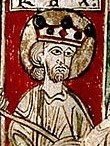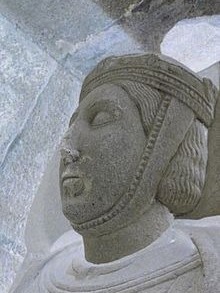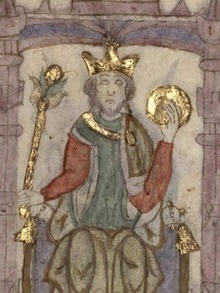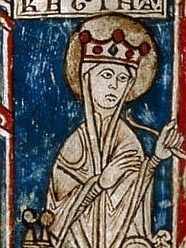Familienstammbaum Snelder - Versteegh » King Alfonso VIII of Castile (1155-1214)
Persönliche Daten King Alfonso VIII of Castile
Quelle 1- Er wurde geboren am 11. November 1155 in Soria.
- Glaube: Catholicism.
- Er ist verstorben am 6. Oktober 1214 in Gutierre-Muñoz, er war 58 Jahre alt.
- Er wurde beerdigt am 6. Oktober 1214 in Monasterio de Santa María la Real de las Huelgas, Burgos, Burgos, Castilla y León, España.
- Ein Kind von Sancho III of Castile und Blanca of Navarra
Familie von King Alfonso VIII of Castile
Er ist verheiratet mit Eleanor of England.
Sie haben geheiratet.
Kind(er):
Notizen bei King Alfonso VIII of Castile
https://en.wikipedia.org/wiki/Alfonso_VIII_of_Castile
Alfonso VIII (11 November 1155[2] – 5 October 1214), called the Noble (El Noble) or the one of the Navas (el de las Navas), was the King of Castile from 1158 to his death and King of Toledo.[3][4] He is most remembered for his part in the Reconquista and the downfall of the Almohad Caliphate. After having suffered a great defeat with his own army at Alarcos against the Almohads in 1195,[5] he led the coalition of Christian princes and foreign crusaders who broke the power of the Almohads in the Battle of Las Navas de Tolosa in 1212, an event which marked the arrival of a tide of Christian supremacy on the Iberian peninsula.[6]
His reign saw the domination of Castile over León and, by his alliance with Aragon, he drew those two spheres of Christian Iberia into close connection.
Alfonso was born to Sancho III of Castile and Blanche, in Soria on 11 November 1155.[7] He was named after his grandfather Alfonso VII of León and Castile, who divided his kingdoms between his sons. This division set the stage for conflict in the family until the kingdoms were re-united by Alfonso VIII's grandson, Ferdinand III of Castile.[8]
His early life resembled that of other medieval kings. His father died in 1158. Though proclaimed king when only two years of age,[6] Alfonso was regarded as merely nominal by the unruly nobles to whom a minority was convenient. Immediately, Castile was plunged into conflicts between the various noble houses vying for ascendancy in the inevitable regency. The devotion of a squire of his household, who carried him on the pommel of his saddle to the stronghold of San Esteban de Gormaz, saved him from falling into the hands of the contending factions.[9] The noble houses of Lara and Castro both claimed the regency, as did the boy's uncle, Ferdinand II of León. In 1159 the young Alfonso was put briefly in the custody of García Garcés de Aza, who was not wealthy enough to support him. In March 1160 the Castro and Lara met at the Battle of Lobregal and the Castro were victorious, but the guardianship of Alfonso and the regency fell to ;Manrique Pérez de Lara.
Alfonso was put in the custody of the loyal village Ávila. At barely fifteen, he came forth to do a man's work by restoring his kingdom to order. It was only by a surprise that he recovered his capital Toledo from the hands of the Laras.[9]
During the regency, his uncle Sancho VI of Navarre took advantage of the chaos and the king's minority to seize lands along the border, including much of La Rioja. In 1170, Alfonso sent an embassy to Bordeaux to Henry II of England and Eleanor of Aquitaine to seek the hand of their daughter Eleanor.[10] Due to the bride's young age of 9, the marriage was finalized at Burgos, before 17 September 1177.[11] The marriage treaty helped provide Alfonso with a powerful ally against his uncle. In 1176, Alfonso asked his father-in-law to arbitrate the disputed border territories. While Alfonso received back much which had been taken from him, he did have to pay significant monetary compensation.[10]
In 1186, he recuperated part of La Rioja from the Kingdom of Navarre.[citation needed]
In 1187, Alfonso negotiated with Frederick I, Holy Roman Emperor who was seeking to marry his son Conrad to Alfonso's eldest child and heir, Berengaria. In April 1188 they agreed on a treaty in Seligenstadt which made clear that she was the heir of Castile after any sons of Alfonso, and that Conrad would only co-rule as her spouse. This became relevant in her ultimate succession to the throne, even though the marriage to Conrad was never consummated and later annulled. The treaty also documented traditional rights and obligations between the sovereign and the nobles in Castile. In July 1188, Alfonso convened his court in Carrión de los Condes to allow the nobles to review and ratify the treaty. At that court, Alfonso knighted both Conrad and Alfonso IX of León, who would ultimately marry Berengaria. The younger Alfonso had come to seek the support and acknowledgement of his ascent to the throne of León from his older cousin. The elder Alfonso granted this in exchange for acknowledgement that the king of Castile was overlord of the king of León.[12]
The relationship between the cousins Alfonso continued to be filled with conflict. In 1194, the papal legate negotiated a treaty between them to temporarily end the conflict. However, after Castile was defeated at the Battle of Alarcos, the younger Alfonso seized the opportunity to again attack his cousin. Castille defended itself with papal support. A more lasting peace was achieved finally by the older Alfonso's daughter Berengaria getting married to the younger Alfonso in 1197.[13] The annulment of this marriage by the pope drove the younger Alfonso to again attack his cousin in 1204, but treaties made in 1205, 1207, and 1209 each forced him to concede further territories and rights.[14][15] The treaty in 1207 is the first existing public document in the Castilian dialect.[16]
Around 1200 when his brother in law John was on the English throne, Alfonso began to claim that Gascony was part of Eleanor's dowry, though there was nothing in the marriage treaty to indicate this. In 1205, he invaded, hoping to make good on his claim. By 1208, he gave up on the venture, though his heirs would come back to this claim generations later.[17]
In 1174, he ceded Uclés to the Order of Santiago and afterwards this became the order's principal seat. From Uclés, he began a campaign which culminated in the reconquest of Cuenca in 1177. The city surrendered on 21 September, the feast of Saint Matthew, ever afterwards celebrated by the citizens of the town.
Alfonso took the initiative to ally all Christian kingdoms of the peninsula — Navarre, León, Portugal, and Aragon — against the Almohads. By the Treaty of Cazola of 1179, the zones of expansion of each kingdom were defined.
After founding Plasencia (Cáceres) in 1186, he embarked on a major initiative to unite the Castilian nobility around the Reconquista.
In 1195, after the treaty with the Almohads was broken, he came to the defence of Alarcos on the river Guadiana, then the principal Castilian town in the region. At the subsequent Battle of Alarcos, he was roundly defeated by the caliph Abu Yusuf Yaqub al-Mansur. The reoccupation of the surrounding territory by the Almohads was quickly commenced with Calatrava falling first. For the next seventeen years, the frontier between Moor and Castilian was fixed in the hill country just outside Toledo.
Finally, in 1212, through the mediation of Pope Innocent III, a crusade was called against the Almohads. Castilians under Alfonso, Aragonese and Catalans under Peter II, Navarrese under Sancho VII, and Franks under the archbishop of Narbonne, Arnaud Amalric, all flocked to the effort. The military orders also lent their support. Calatrava first, then Alarcos, and finally Benavente were captured before a final battle was fought at Las Navas de Tolosa near Santa Elena on 16 July. The caliph Muhammad al-Nasir was routed and Almohad power broken.[6]
Alfonso was the founder of the first Spanish university, a studium generale at Palencia, which, however, did not survive him.[9] His court also served as an important instrument for Spanish cultural achievement. Alfonso and his wife Eleanor of England were the first to make the Alcázar of Segovia as their resident when this fortress was still at its early stages.
Alfonso died at Gutierre-Muñoz[18] ;and was succeeded by his surviving son, Henry I.
Alfonso was the subject for Lion Feuchtwanger's novel Die Jüdin von Toledo (The Jewess of Toledo), in which is narrated an affair with a Jewish subject in medieval Toledo in a time when Spain was known to be the land of tolerance and learning for Jews, Christians, and Muslims. The titular Jewish woman of the novel is based on Alfonso's paramour, Rahel la Fermosa.[19] Scholars continue to debate the historical truth of this relationship.[20] The 1919 film The Jewess of Toledo by Franz Höbling ;is also based on this relationship.[21]
Children[edit]
With Eleanor of England,[22] Alfonso had 11 children:[23]
Name Birth Death Notes Berengaria Burgos,
1 January/
June 1180Las Huelgasnear Burgos,
8 November 1246Married firstly in Seligenstadt on 23 April 1188 with Duke Conrad II of Swabia, but the union (only by contract and never solemnized) was later annulled. Married in Valladolidbetween 1/16 December 1197 with King Alfonso IX of León as his second wife.[24] After their marriage was dissolved on grounds of consanguinity in 1204, she returned to her homeland and became regent of her minor brother King Henry I. Queen of Castile in her own right after the death of Henry I in 1217, quickly abdicated in favor of her son Ferdinand III of Castile who would re-unite the kingdoms of Castile and León. Sancho Burgos,
5 April 118126 July 1181 Heir of the throne since his birth, died aged three months. Sancha 20/28 March 1182 3 February 1184/
16 October 1185Died in infancy. Henry 1184 1184? Heir of the throne since his birth, died either shortly after being born or in infancy. His existence is disputed among sources. Urraca 1186/
28 May 1187Coimbra,
3 November 1220Queen of Afonso II of Portugal Blanche Palencia,
4 March 1188Paris,
27 November 1252Married to Louis VIII of France Ferdinand Cuenca,
29 September 1189Madrid,
14 October 1211Heir of the throne since his birth. On whose behalf Diego of Acebo and the future Saint Dominic travelled to Denmark in 1203 to secure a bride.[25] Ferdinand was returning through the San Vicente mountains from a campaign against the Muslims when he contracted a fever and died.[26] Mafalda Plasencia,
1191Salamanca,
1211Betrothed in 1204 to Infante Ferdinand of Leon, eldest son of Alfonso IX and stepson of her oldest sister. Eleanor 1200[27] Las Huelgas,
1244Married in Ágreda on 6 February 1221 with James I of Aragon. Constance c. 1202[27] Las Huelgas,
1243A nun at the Cistercian monastery of Santa María la Real at Las Huelgas in 1217, she became known as the Lady of Las Huelgas, a title shared with later royal family members who joined the community.[27] Henry Valladolid,
14 April 1204Palencia,
6 June 1217Only surviving son, he succeeded his father in 1214 aged ten under the regency firstly of his mother and later his oldest sister. He was killed when he was struck by a tile falling from a roof. Through his daughters, Berengaria and Blanche, he was the grandfather of two monarchs who became saints of the Roman Church.
Zeitbalken King Alfonso VIII of Castile
 Großeltern
Großeltern
 Eltern
Eltern
 Geschwister
Geschwister
 Kinder
Kinder
Vorfahren (und Nachkommen) von Alfonso VIII of Castile
Alfonso VIII of Castile  | ||||||||||||||||||||||||||||||||||
Eleanor of England | ||||||||||||||||||||||||||||||||||
Verwandschaft King Alfonso VIII of Castile
- Alfonso VIII of Castile ist der Ur(x50)enkelsohn von Titus Manlius Imperiosus Torquatus:Titus Manlius Imperiosus TorquatusTitus Manlius TorquatusTitus Manlius TorquatusAulus Manlius TorquatusTitus Manlius TorquatusDecimus Junius Silanus ManlianusMarcus Junius Silanus consulMarcus Junius SilanusMarcus Junius Silanus consulMarcus Junius SilanusJunia Calvina EquitusGaius SallustiusGaius Ummidius Quadratus SallustiusGaius Ummidius Quadratus Annianus VerusGaius Ummidius Quadratus Annianus Verus FulviusUmmidia Commificia AntoniaPendania Pedanius FuscusMariana MinorAurelia PompeianaClaudiaConstantius I Chlorus of RomeUnkownProcopius UsurperProcopiusProcopius II Magister Militum of ByzantiumProcopius Anthemius I of the of the Western Roman EmpireAlypia Princess of the of RomeCaratene Agrippina of NarbonneClothilde of BurgundyChlothar I of the FranksCharibert I of ParisBilichildeArnoald of MetzDodaAnsegisel of the FranksPepin II of HerstalCharles Martel of the FranksCarloman of the FranksRotrudeBeague l of ParisEngeltrude of ParisEberhard of FriuliBerengar I of the Holy Roman EmpireGisela of FriuliBerengar II of ItalyAdalbert II of ItalyOtto-William of BurgundyReginald I of BurgundyWilliam I of BurgundyRaymond of Burgundy and GaliciaAlfonso VII of CastilleSancho III of CastileAlfonso VIII of Castile
Quellen
- Biographical Summaries of Notable People, via https://www.myheritage.nl/research/colle...
Alfonso Viii of CastileGeslacht: ManGeboorte: 11 nov 1155 - SoriaOverlijden: 6 okt 1214 - Gutierre-MuñozReligion: Catholicism Familieleden: RelatieNaamGeboorteMoederBlanche of Navarre, Queen of Castile1133VaderSancho III of Castile1134DochterBlanche of Castile4 mrt 1188DochterBerengaria of Castile1 jun 1180DochterEleanor of Castile1202ZoonHenry I of Castile14 apr 1204DochterUrraca of Castile, Queen of Portugal28 mei 1187EchtgenoteEleanor of England, Queen of Castile13 okt 1162
The records in this collection vary in what data items are present and one will find information on various aspects of the subject persons including names, biographical descriptions, nationalities, birth dates, birth places, death dates, death places, relatives, spouses, children, professions, nationalities, and educational attainment. The information in this collection has been compiled from Freebase (under CC-BY) and Wikipedia (under the GNU Free Documentation License).
Anknüpfungspunkte in anderen Publikationen
Diese Person kommt auch in der Publikation vor:Historische Ereignisse
Sterbedatum 6. Oktober 1214
- Graaf Willem I (Hollands Huis) war von 1203 bis 1222 Fürst der Niederlande (auch Graafschap Holland genannt)
Gleicher Geburts-/Todestag
- 1050 » Heinrich IV., deutscher König und Kaiser des Heiligen Römischen Reiches
- 1154 » Sancho I., portugiesischer König
- 1155 » Alfons VIII., König von Kastilien
- 1220 » Alfons von Poitiers, Graf von Poitou, Graf von Toulouse und Markgraf der Provence
- 1232 » Håkon Håkonsson unge, König von Norwegen
- 1289 » Nicholas Audley, 2. Baron Audley of Heleigh, englischer Magnat
- 1173 » Engelbert III., Markgraf von Istrien und Graf von Kraiburg-Marquartsstein
- 1180 » Amalrich von Nesle, Patriarch von Jerusalem
- 1201 » Johannes V. Bavor, Bischof von Olmütz
- 1206 » Arthold von Belley, Bischof von Belley und Kartäuser
- 1208 » Geoffrey de Muschamp, Bischof von Coventry
- 1315 » Weichart von Polheim, Erzbischof von Salzburg
Über den Familiennamen Of Castile
- Zeigen Sie die Informationen an, über die Genealogie Online verfügt über den Nachnamen Of Castile.
- Überprüfen Sie die Informationen, die Open Archives hat über Of Castile.
- Überprüfen Sie im Register Wie (onder)zoekt wie?, wer den Familiennamen Of Castile (unter)sucht.
Roel Snelder, "Familienstammbaum Snelder - Versteegh", Datenbank, Genealogie Online (https://www.genealogieonline.nl/stamboom-snelder-versteegh/I507041.php : abgerufen 20. Juni 2024), "King Alfonso VIII of Castile (1155-1214)".




